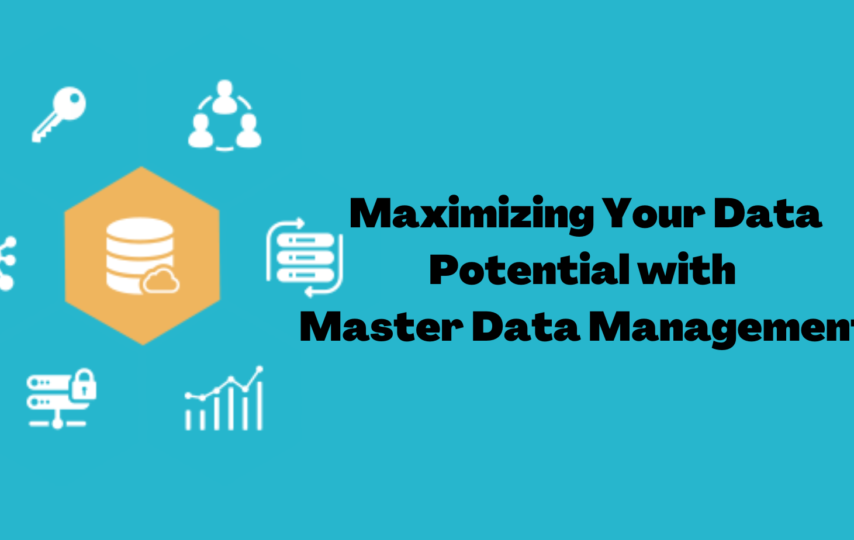In today’s data-driven world, businesses of all sizes are constantly seeking ways to manage their key data assets effectively. However, as the volume and complexity of enterprise data grows, managing it efficiently becomes more challenging. This can lead to decision-making mistakes and inefficiencies, which can be detrimental to the business. This is where master data management (MDM) comes in.
MDM allows companies to create, maintain, and manage a single, accurate, and consistent version of data across their organization. This process is essential for keeping data consistent and up-to-date, ensuring that all parts of the business use the same information. This helps to minimize errors, improve efficiency, and promote better decision-making.
This blog post discusses the essential steps involved in implementing an effective MDM strategy, common challenges, and pitfalls to avoid, and best practices to optimize the process. We also explore emerging MDM trends in 2023 and the benefits of outsourcing data management services for cost-effective solutions.
How to Implement Master Data Management?
Implementing MDM can be a complex process. However, by following certain important steps, you can successfully implement an MDM solution that meets your business goals and improves the quality and consistency of your critical data elements.
Step 1: Define Your Business Goals
This is a crucial step that involves identifying the business processes critical to your organization’s operations and the data elements that support them. For instance, you may consider customer data, product data, and sales data. By identifying these key data elements, you can define the expected outcomes that MDM will enable.
Think about the business challenges that MDM can help solve. These may include inaccuracies in data or the need for streamlining your business processes to improve efficiency. Whatever the case may be, identifying these challenges will help you set clear goals for your MDM process.
Step 2: Assess Current Data Management Practices
Analyzing the existing data management practices is essential for a successful MDM implementation as it helps to understand the current state of data management processes. This involves identifying the systems, applications, and databases that store and manage the data. Review your data governance policies and procedures to see if they align with your data management goals. Understand how your data is used by different departments or business units within your organization. This will help you identify any potential conflicts or redundancies in data collection and usage.
Step 3: Select MDM Solution
Once you have identified your goals and assessed your current data management practices, you need to choose an MDM solution that suits your needs. Look for a solution that offers a centralized repository for your master data, has strong data governance, and can be easily integrated with your existing systems.
Step 4: Appoint Data Stewards
This is like deploying a team responsible for managing the data and ensuring that it is accurate, consistent, and up-to-date. Appoint data stewards who have a deep understanding of your business processes and critical data elements. They should be able to work closely with the IT team and other stakeholders to ensure that the MDM implementation is successful.
Step 5: Develop and Implement Data Governance Policies
It is crucial to implement data governance policies for effective data management. These policies define data ownership, usage, and quality standards, ensuring accountability and maintenance by designated data owners. Additionally, you should include security protocols and guidelines for data access, use, and sharing.
Step 6: Design the MDM Solution
To design an MDM solution, start by identifying master data entities and creating a model that outlines data structure and relationships. Work with your team to ensure the solution meets business goals. Once designed, implement the solution by migrating data to the centralized repository, setting up workflows, and enforcing data quality rules.
Step 7: Monitor and Improve
To ensure ongoing success, regularly monitor and maintain your MDM solution. Conduct periodic data quality checks, enforce data governance policies, and address any issues promptly. Measure effectiveness, identify areas for improvement, and work with your team to make necessary adjustments to ensure your MDM solution is optimized to support your organization’s objectives.
Pitfalls to Avoid When Implementing MDM
When implementing master data management, there are certain pitfalls that organizations should be aware of to avoid potential setbacks.
- Inadequate Planning:
This is one of the most common challenges. This can be due to various reasons such as incomplete requirement collection or not having a clear understanding of the project’s goals and objectives. This can lead to unrealistic timelines and a lack of clarity about the project’s scope.
- Poor Data Quality:
MDM is designed to improve the quality and consistency of master data across an organization, but if the raw data being used for the process is of poor quality, it can have a negative impact on the effectiveness of the MDM solution.
- Resistance to Change:
Implementing MDM can require significant changes to an organization’s processes, workflows, and culture. Resistance to change can result in delays, additional costs, and lower adoption rates.
- Integration Issues:
MDM implementations in complex IT environments can encounter integration issues, which can arise due to the diverse range of systems and data sources involved.
- Insufficient Budget:
MDM implementations can be costly, and budgetary limitations can hinder the success of the initiative. Without adequate funding, it may be difficult to implement the necessary systems, processes, and governance frameworks to support MDM.
Tips for Optimizing MDM Implementation
Implementing MDM can be a complex process, and the challenges can put you in a tough spot. But don’t worry- we’ll walk you through some tips that you can follow to optimize the process and avoid the pitfalls.
- Involve Stakeholders:
Involve all the relevant stakeholders from the beginning of the project to ensure their buy-in and participation. This includes business users, IT teams, data stewards, and executives.
- Set Realistic Goals:
Define clear and measurable goals for your MDM initiative. Make sure they align with your overall business objectives.
- Start with a Pilot Project:
Begin with a pilot project to test the MDM solution before scaling it to the entire organization.
- Prioritize Data Elements:
Identify the most critical data elements for your organization and prioritize them in the implementation process.
- Establish Data Quality Standards:
Define data quality standards that are specific, measurable, and achievable.
- Ensure Data Security:
Implement robust data security measures to protect sensitive data from unauthorized access or cyber threats.
- Provide Training and Support:
Offer comprehensive training and support to all users of the MDM system. This can include data stewards, data analysts, and business users.
Incorporating these tips and strategies aims to ensure a smooth and efficient process of MDM implementation.
Looking ahead to 2023, several emerging trends in MDM offer further opportunities for optimization. In the next section, we’ll deep dive into the latest advancements that have transformed the MDM landscape in 2023.
Master Data Management Trends in 2023
As data volume grows and organizations continue to face new challenges in managing their enterprise data, it’s important to stay up-to-date with the latest trends and technologies of MDM.
Let’s take a closer look at some of the emerging trends in master data management in 2023:
- Increased Adoption of Cloud-based MDM Solutions:
Cloud-based MDM solutions are gaining popularity among businesses as they provide scalability, flexibility, and cost-effectiveness. By storing and managing data securely in the cloud, businesses can access it from anywhere and at any time, using a web-based interface.
- Artificial Intelligence and Machine Learning:
AI and ML technologies provide advanced capabilities to improve data management. With these technologies, businesses can automate MDM tasks, such as data quality assessment and data matching. They can also leverage AI and ML to identify patterns and trends within large data sets for deeper insights and informed decisions.
- Integration with Other Data Management Solutions:
Integrating MDM with other solutions improves the data ecosystem and governance. It offers a comprehensive approach to data management, ensuring high-quality and consistent master data throughout the organization.
- Leveraging Blockchain Technology:
Blockchain is increasingly being used in MDM systems as it can revolutionize data storage, management, and sharing. With blockchain, data is tamper-proof and immutable, ensuring authenticity and accuracy. It can eliminate intermediaries and increase efficiency, transparency, and security in MDM. It can also improve data privacy and protection by providing secure and private data sharing.
Leveraging these modern approaches can help businesses improve the accuracy, security, and efficiency of managing critical data assets. However, with the complexity of data management increasing rapidly, many businesses struggle to keep up with MDM needs in-house and miss out on the latest advancements. Outsourcing data management services can be a wise option in such scenarios.
Why Outsourcing Data Management Services Is a Viable Option?
While investing in the latest trends and technologies can certainly bring significant benefits, not every organization has the resources or expertise to handle it in-house. Outsourcing data management services can not only alleviate the burden on internal IT teams but also bring about a range of benefits including:
- Cost Savings:
Outsourcing master data management needs can be more cost-effective than managing it in-house, as it eliminates the need for companies to invest in software, hardware, and additional personnel.
- Boosts Productivity:
With efficient master data management, you can increase the productivity of your business by providing easy access to data, allowing in-house employees to effectively focus on core business activities.
- Improved Efficiency:
When data is managed and updated properly, it leads to better accessibility and eliminates errors that can waste valuable time and resources.
- Enhanced Data Quality:
The right data management company can assist in enhancing the quality of your data, which, in turn, leads to more accurate decision-making and improved business activities.
- Access to Expertise:
You can leverage a team of experts with the latest knowledge and skills in the field.
- Increased Flexibility:
Outsourcing master data management can provide more flexibility in terms of scalability as service providers can often customize their solutions to meet changing needs.
- Reduces Data Loss:
Loss of data can have a devastating impact on any business. Outsourcing master data management needs can reduce the risk of data loss and ensure that all data is backed up and easily retrievable in case of any unexpected events.
- Improved Compliance:
By partnering with a trusted service provider, businesses can ensure compliance with relevant regulations and standards, such as GDPR and ISO, by implementing appropriate data security and privacy measures.
With these benefits in mind, outsourcing data management services can be a smart choice for organizations looking to streamline their data processes and improve their overall efficiency.
Endnote
Master data management is a key practice for businesses looking to thrive in today’s data-driven landscape. By taking a comprehensive approach toward data management, businesses can improve the quality of their data, establish a “single source of truth,” and enhance the decision-making process.
Furthermore, the importance of master data management cannot be overstated in 2023 and beyond. As the need for precise data continues to grow, the benefits of MDM will only become more significant. Hence, by following the best practices and being aware of the pitfalls of MDM, you can unlock the full potential of your data assets and take your business to new heights.








